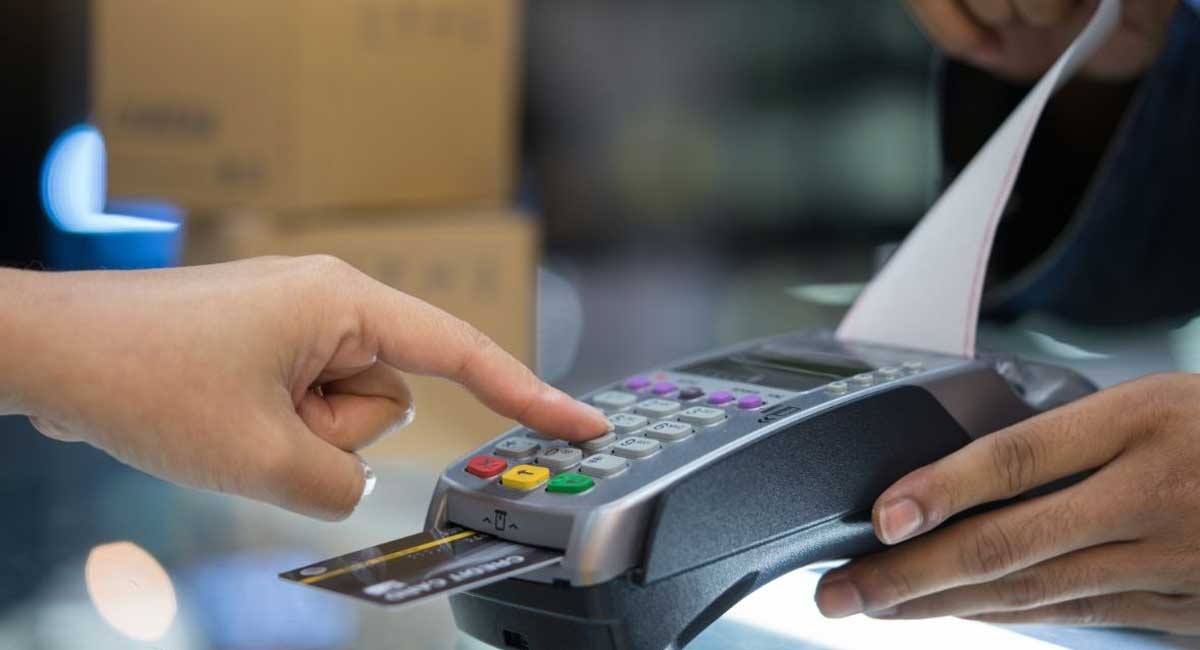How To Accept Credit Card Payments? Mastering The Art Of Credit Card Payments
Discover the essential steps on how to accept credit card payments seamlessly. From setting up a merchant account and integrating payment gateways to ensuring security compliance and providing transparent pricing, learn the ins and outs of optimizing your payment process.
Author:Habiba AshtonReviewer:Gordon DickersonDec 27, 20233.3K Shares76.9K Views

Accepting credit card payments is a crucial aspect of modern business, providing convenience for both merchants and customers. With the widespread use of credit and debit cards, businesses that can accept these payments have a competitive edge. So, how to accept credit card payments?
Cash payments have been declining for some time, and with the pandemic's lingering impacts and the growing availability of contactless payment options, wallets are being left at home entirely. With so many alternatives to cash, it can be difficult for a small business to figure out how to begin accepting credit card payments.
Many entrepreneurs today are too young to remember the old-school credit card imprinters, you know, those cumbersome plastic devices that made a carbon print of a credit card next to a handwritten receipt?
Fortunately for us, advances in payment processing technology over the last 30 years have made accepting credit cards easier than ever. Furthermore, many of today's top credit card processing services combine payments with other features like e-commerce and inventory management.
Accepting credit and debit card payments is a simple approach for your company to grow sales and enhance customer service. While credit and debit cards continue to be the most common payment methods for in-store purchases, they were also utilized for 35% of global internet transactions in 2020, reaching $4.2 trillion. If your company does not accept credit cards, you are missing out on significant revenue prospects.
Credit and debit card payments are important for more than just shops. Even firms that do not sell tangible things are increasingly providing online card payment options to customers, either before or after providing services.
In this post, we'll show you how to accept credit card payments in a few easy steps.
Understanding The Basics Of Credit Card Payments
Accepting credit card payments involves navigating a system with several key components. At the core of this process are merchant accounts, payment gateways, and the underlying infrastructure that facilitates seamless transactions.
Merchant Account Overview
To take credit card payments, you need to open a special type of bank account known as a merchant account. Sign up with a bank, arrange a fee contract, and then obtain or purchase the appropriate hardware to process payments.
A merchant account serves as a bridge between your business and the financial networks that process credit card transactions. It's a specialized bank account designed to hold funds from credit card sales before they are transferred to your business bank account. To obtain a merchant account, you typically need to apply through a bank or a payment processor.
Payment Gateways Explained
A payment gateway is a technological intermediary that facilitates the secure transfer of information between a customer's credit card and your merchant account. Think of it as a virtual point-of-sale terminal for online transactions. When a customer makes a purchase, the payment gateway encrypts the sensitive information, authorizes the transaction, and ensures that funds are transferred correctly.
Choosing The Right Payment Processor
Selecting the right payment processor is a critical decision that directly impacts your ability to accept credit card payments efficiently. Different processors offer various features, fee structures, and levels of service. Here's a breakdown of considerations when choosing a payment processor:
Transaction Fees
Transaction fees are charges applied to each credit card transaction. They can vary significantly among payment processors. Some processors may offer a flat fee per transaction, while others may use a combination of flat fees and a percentage of the transaction amount. Consider your business's typical transaction size and volume to choose a cost-effective solution.
Setup Costs
Some payment processors charge setup fees when you create an account. These fees can include costs for hardware (if applicable) or account activation. Many modern processors, however, have moved away from upfront setup costs, making it more accessible for businesses of all sizes to get started.
Accepted Card Types
Ensure that the payment processor you choose accepts a broad range of credit cards. While major credit card brands like Visa and Mastercard are widely accepted, some processors may have limitations. Make sure that your chosen processor accommodates the cards most commonly used by your customer base.
Integration Options
Consider the ease of integrating the payment processor with your existing systems. Many processors offer plugins and APIs that make integration straightforward. This is crucial for ensuring a smooth checkout experience for your customers, whether online or in-person.
Setting Up A Merchant Account
Setting up a merchant account is a foundational step in accepting credit card payments. This involves a relationship with a bank or a financial institution that enables your business to receive funds from credit card transactions. Here's a step-by-step guide to setting up a merchant account:
Start by researching potential providers. This could be your current bank or a specialized payment processor. Consider factors such as transaction fees, setup costs, and the provider's reputation for customer service.
Once you've chosen a provider, initiate the application process. This often involves providing information about your business, such as its structure, processing history, and financial stability. Be prepared to submit documentation to support your application.
After completing the application, your provider will review the information and, if everything is in order, approve your merchant account. You'll then receive the necessary credentials, including a merchant ID and access to the payment gateway, to integrate into your systems.
Integration With Payment Gateway
Integrate your merchant account with a payment gateway. This step is crucial for enabling the secure transfer of data between your customers, your website or point-of-sale system, and your merchant account. The integration process varies depending on your chosen payment processor and the systems you use.
Before officially accepting credit card payments, conduct thorough testing to ensure that the integration works seamlessly. Many payment processors offer sandbox environments for testing transactions without processing real payments. Once testing is successful, you can launch and start accepting credit card payments from customers.
Integrating A Payment Gateway
Integrating a payment gateway is a crucial step in the process of accepting credit card payments, especially in the digital landscape. A payment gateway acts as the bridge between your website or point-of-sale system and the financial networks that process credit card transactions.
Choose a payment gateway that aligns with your business's needs. Many payment processors offer their own gateways, but you can also opt for third-party gateways that integrate with multiple processors. Consider factors such as transaction fees, ease of integration, and compatibility with your existing systems.
The integration process varies depending on your chosen payment processor and the systems you use. Most payment gateways provide documentation and support to help developers seamlessly integrate the gateway into your website or application. Ensure that the integration is robust, secure, and user-friendly.
Before going live, conduct thorough testing to ensure that the payment gateway is working correctly. Many payment processors offer sandbox environments for testing, allowing you to simulate transactions without processing real payments. Test various scenarios to identify and address any potential issues.
Providing Multiple Payment Options
To cater to a diverse customer base and enhance the overall customer experience, it's essential to provide multiple payment options beyond credit cards. Diversifying payment methods can contribute to increased customer satisfaction and loyalty. Here's how you can achieve this:
Digital Wallets
Integrate popular digital wallets like Apple Pay, Google Pay, and Samsung Pay. These wallets offer a convenient and secure way for customers to make payments using their smartphones. Providing support for digital wallets is increasingly important in a mobile-centric world.
Bank Transfers
Offer bank transfer options for customers who prefer direct transfers from their bank accounts. This can be particularly relevant for high-value transactions or in regions where bank transfers are commonly used.
Educating Your Staff
While the technological aspects of accepting credit card payments are crucial, the human element is equally important. Educating your staff on the intricacies of credit card transactions, security measures, and customer interactions contributes to a smooth and secure payment process. Here's how to ensure your staff is well-informed:
Training Programs
Implement comprehensive training programs for staff members involved in the payment process. This includes front-line staff, customer support, and anyone handling payment-related inquiries.
Security Protocols
Educate staff on security protocols, emphasizing the importance of protecting customer information. This includes guidelines on handling physical cards, securing payment terminals, and recognizing potential signs of fraudulent activity.
Customer Interaction
Train staff to effectively assist customers with payment-related inquiries. This includes troubleshooting common issues, explaining transaction processes, and providing guidance on using different payment methods.
Stay Informed
Encourage ongoing education for your staff to stay informed about updates in the payment industry, changes in security standards, and advancements in technology. This ensures that your team remains well-equipped to handle evolving payment scenarios.
Addressing Concerns
Equip staff with the skills to address customer concerns related to credit card payments. This may involve handling disputes, providing refunds, and ensuring a positive customer experience even in challenging situations.
Transparent Pricing In Credit Card Processing
Transparency in pricing is crucial when it comes to accepting credit card payments. Customers appreciate clarity about the costs associated with transactions, and businesses benefit from building trust. Here's a detailed exploration of transparent pricing in the context of credit card payments:
Breakdown Of Fees
Provide a clear breakdown of the fees associated with credit card transactions. This includes transaction fees, interchange fees, and any additional charges. Transparency helps customers understand the true cost of using credit cards and builds trust in your business.
Flat Rate Vs. Interchange-Plus Pricing
Explain the pricing model you adopt. Some businesses opt for a flat-rate pricing model, where a fixed percentage and fee are charged for each transaction. Others use interchange-plus pricing, which passes the actual interchange fee directly to the customer, providing more transparency.
Disclose Any Additional Charges
If there are any additional charges, such as chargeback fees or monthly subscription fees for payment processing services, clearly disclose them. Hidden fees can lead to customer dissatisfaction and erode trust.
Billing Statements
Ensure that your billing statements are clear and easy to understand. Provide a detailed breakdown of each transaction, including the date, amount, and associated fees. This transparency helps customers reconcile their records and minimizes disputes.
Regularly Update Systems
Staying current with technological advancements and security updates is essential when accepting credit card payments. Regularly updating your systems ensures that you provide a secure and reliable payment process for both your business and your customers.
Regularly update your payment systems with the latest security patches. Cybersecurity threats evolve, and updating your systems helps protect against potential vulnerabilities. This is particularly critical in maintaining compliance with industry standards such as PCI DSS.
Keep your payment processing software up-to-date. Software updates often include bug fixes, performance improvements, and compatibility enhancements. Regularly checking for and applying updates ensures optimal functionality.
If you use physical card terminals or point-of-sale systems, consider hardware upgrades when necessary. Newer hardware often comes with enhanced security features and improved efficiency. Upgrading ensures that you're utilizing the latest technology in your payment processes.
Customer Support Solutions For Payment Processing Issues
Effective customer support is a cornerstone of a successful credit card payment system. Providing prompt and helpful support not only resolves issues quickly but also contributes to positive customer experiences.
Offer customer support through multiple channels, including phone, email, and live chat. Providing diverse communication options ensures that customers can reach out in their preferred way, increasing accessibility.
Ensure that your customer support staff is well-trained and knowledgeable about credit card transactions. They should be able to address common issues, provide guidance on the payment process, and troubleshoot technical problems.
Strive for quick response times to customer inquiries. Prompt responses instill confidence in your business and demonstrate a commitment to customer satisfaction. Utilize automated responses or acknowledgment systems to set expectations regarding response times.
Monitoring Transactions
Monitoring transactions is a crucial aspect of managing credit card payments. It involves staying vigilant for irregularities, and potential fraud, and ensuring that all transactions align with your business policies. Here's a detailed breakdown of effective transaction monitoring:
Automated Monitoring Tools
Implement automated monitoring tools that can analyze transaction patterns, detect anomalies, and flag potentially fraudulent activities. These tools use algorithms to identify unusual behavior and trigger alerts for further investigation.
Regular Review Of Transaction Reports
Regularly review transaction reports to identify patterns or trends. Pay attention to chargeback rates, unusually high transaction volumes, or discrepancies in transaction data. Timely review allows for swift action in case of any abnormalities.
Fraud Prevention Measures
Incorporate fraud prevention measures within your transaction monitoring process. This may include address verification, card verification value (CVV) checks, and real-time authorization. These measures help prevent fraudulent transactions before they occur.
Manual Review For High-Risk Transactions
For high-risk transactions, implement a manual review process. This involves a human intervention to scrutinize transactions that automated systems flag as potentially problematic. Manual reviews add an extra layer of security.
Communication With Customers
In cases where a transaction appears suspicious, communicate promptly with the customer. Contact them to verify the legitimacy of the transaction, providing an additional layer of security while also offering excellent customer service.
How To Accept Credit Card Payments? - FAQs
How Do I Set Up A Merchant Account For Accepting Credit Card Payments?
To set up a merchant account, contact your bank or a financial institution, and follow their application process. Once approved, you'll receive the necessary credentials to integrate with a payment gateway.
Which Payment Processors Are Recommended For Accepting Credit Card Payments?
Popular payment processors include Stripe, PayPal, Square, and others. Choose one that aligns with your business needs, considering factors like transaction fees and the range of cards accepted.
What Is PCI DSS, And Why Is It Important For Credit Card Security?
PCI DSS stands for Payment Card Industry Data Security Standard. It is a set of security standards designed to protect sensitive customer information during credit card transactions. Adhering to PCI DSS guidelines is crucial for security compliance.
How Can I Make My Website/mobile App Compatible For Accepting Credit Card Payments On Mobile Devices?
Optimize your website or mobile app to be mobile-friendly. Ensure that the payment process is seamless on different devices, providing a user-friendly experience for customers using smartphones or tablets.
What Are Interchange Fees, And How Do They Affect Credit Card Transactions?
Interchange fees are fees paid by merchants to the card-issuing bank for accepting credit card transactions. It's essential to be aware of these fees as part of the overall cost of processing credit card payments.
What Are Some Additional Payment Options I Can Offer Besides Credit Cards?
Consider integrating digital wallets, bank transfers, and other popular payment options to cater to a wider audience and enhance the overall customer experience.
Conclusion
How to accept credit card payments? Accepting credit card payments involves a combination of technological integration, security measures, and customer service excellence. By understanding the fundamentals, choosing the right partners, and staying proactive in maintaining a secure and user-friendly payment process, your business can effectively harness the benefits of credit card transactions.
Jump to
Understanding The Basics Of Credit Card Payments
Choosing The Right Payment Processor
Setting Up A Merchant Account
Integrating A Payment Gateway
Providing Multiple Payment Options
Educating Your Staff
Transparent Pricing In Credit Card Processing
Regularly Update Systems
Customer Support Solutions For Payment Processing Issues
Monitoring Transactions
How To Accept Credit Card Payments? - FAQs
Conclusion

Habiba Ashton
Author

Gordon Dickerson
Reviewer
Latest Articles
Popular Articles

